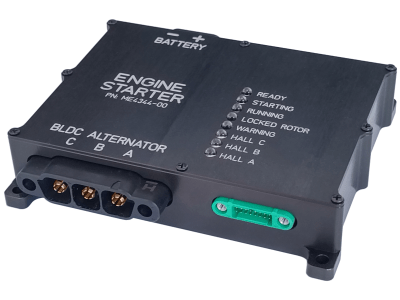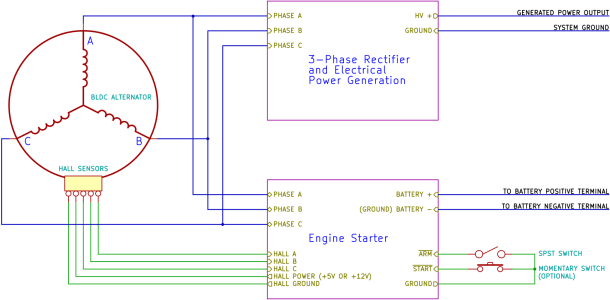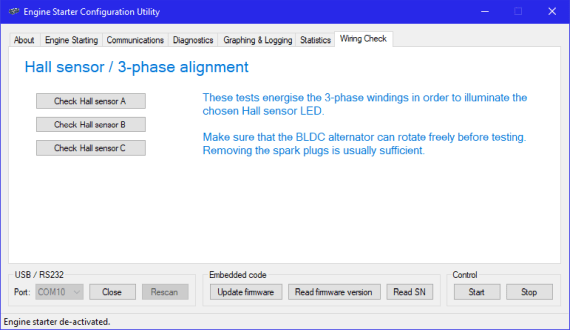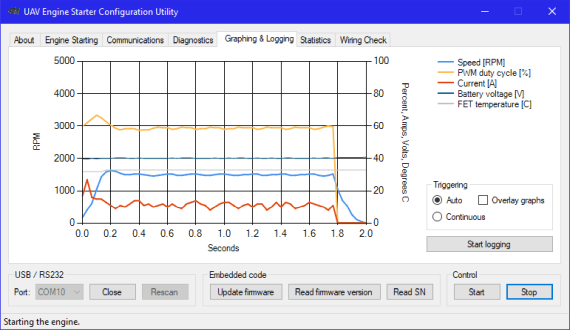UAV Engine Starter

UAV Engine Starter
The UAV Engine Starter is designed to start internal combustion engines up to 150cc in size. It is small, lightweight, and delivers rapid and reliable engine starting without the use of decompression valves.
The engine starter drives the BLDC alternator as a motor in order start the engine. Once the engine is running the starter disconnects itself from the BLDC alternator to allow electrical power generation. A suitable BLDC alternator fitted with Hall sensors is required.
Engine starting is initiated locally by push-button or remotely using CAN or RS232 commands. In-flight restarts are possible with CAN or RS232 commands.
Features:
- Rapid and reliable starting - 1500RPM is typically achieved in under 0.5 Seconds.
- Maximum torque available from standstill.
- Operates from battery voltages of 20 to 55VDC. Tolerates generated 3-phase voltages up to 140VAC.
- CAN, RS232 and USB connectivity.
- Comprehensive front-panel diagnostics to aid integration and commissioning.
- User-friendly configuration software, with integrated graphing and logging to optimise and verify performance.
- Weight: 190 grams (6.7 ounces).
- Dimensions: 93.5 x 80.5 x 20mm.
Why not just use an ESC as an engine starter?
Absolutely an ESC can be used to start an internal combustion engine, but there are some major disadvantages and design challenges to overcome. Here are a couple:
- Torque at zero speed is the #1 requirement for successful engine starting - all of the action happens in the first couple of hundred milliseconds. Sensored operation is the only way to guarantee torque at zero speed, and not all ESCs support this. Although a sensorless ESC may be able to start an engine under some circumstances, it is essentially a lottery - it will never be as reliable or as fast as a sensored solution.
- Back-EMF tolerance. If the engine starts then the BLDC motor becomes an alternator, generating 3-phase power. Unless a 3-phase isolation circuit is present the generated voltage must never exceed the battery voltage or uncontrolled battery charging occurs. This is obviously catastrophic. ESCs do not include an isolation circuit, and so the Kv of the BLDC alternator must be chosen very carefully and this limits the range of alternators that can be used. Most of the commonly available BLDC alternators intended for UAV applications generate over 80V at maximum RPM, ruling them out of contention.
This engine starter suffers from none of these problems. It can produce maximum torque at zero speed. It can operate from battery voltages as low as 20V and is able to withstand generated 3-phase voltages of up to 140VAC. It can use a wide range of off-the-shelf BLDC alternators.
Purchasing:
The UAV Engine Starter is distributed in Europe by VISIONAIRtronics.
If you are located closer to Australia, you can choose to purchase from Millswood Engineering.
Quality:
The UAV Engine Starter is manufactured in an ISO9001:2015 compliant facility using lead-free components and processes. Completed Engine Starters are tested and given a unique serial number to maintain traceability.
Functional description

Wiring diagram
The Engine Starter allows a 3-phase BLDC alternator to be used as a motor to start an internal combustion engine. It requires a source of power capable of delivering high-current, and a BLDC alternator fitted with Hall sensors.
When requested to do so, the starter energises the windings of the BLDC alternator to accelerate the engine up to starting speed. Once the engine starts, the starter disconnects itself electrically from the BLDC alternator. This allows the engine to spin freely and the BLDC alternator to generate electrical power without interference from the starter.
Hall sensor phasing and alignment

Checking Hall sensor phasing and alignment
The engine starter comes with several features that reduce the engineering effort required to achieve successful engine starting.
One of the most common problems with setting up sensored BLDC controllers is getting the phasing right. There are 36 ways of wiring up 3 windings and 3 Hall sensors: 6 of these will work reliably, 12 of them will almost work but not reliably, and the remainder will not work at all and potentially break stuff. Phasing between Hall sensors and windings is difficult to analyse and can take a long time to get right. The engine starter addresses this problem by providing a test mode to verify that each of the Hall sensors is phased and aligned correctly.
It is very simple to do, and it works like this.
Pressing each button in the configuration software energises the windings to align the chosen Hall sensor with the middle of its range. The corresponding Hall sensor LED (on the engine starter itself) then turns on if the Hall sensor is wired up correctly. This allows verification (or correction) of the Hall sensor wiring, and it also allows an assessment to be made of the positional error of each Hall sensor.
Graphing & logging

Graphing & logging
Another feature designed to reduce engineering effort is the graphing and logging available from within the configuration software.
This is trivial to get up and running because of the USB connection to the engine starter. Graphs are created dynamically in real-time, and show all of the key variables. All data is synchronised to the starter's internal state, so there is no aliasing from a secondary sampling process.
If a more permanent record of starting performance is required, then all of the same data can be written to file.
The graph on the right shows a 70cc engine being cranked at 1500RPM. (It has no ignition system fitted, so it's not actually going to start.)
Interesting things that can been seen at a glance:
- From standstill to 1500RPM takes 200ms.
- The peak phase current is 27 Amps.
- The battery voltage (40V) does not droop at all, even when maximum current is drawn.
- There is no appreciable temperature rise.
Less obviously (but derivable from the logged data), the peak torque applied to the engine is 15.7Nm, and the average torque required to maintain 1500RPM at steady state is 1.8Nm.
This is a fairly easy engine to turn over, and so the starter is not working particularly hard.
Product resources
- Documentation:
- Product brief: a short summary of the key features and specifications.
- Product manual: detailed description of the Engine Starter hardware - how it works, how to connect it up, electrical and mechanical specifications, communications protocols, etc.
- Software:
- Configuration utility: a Windows app for configuring the Engine Starter and checking that it is all working correctly.
More resources are available here.



